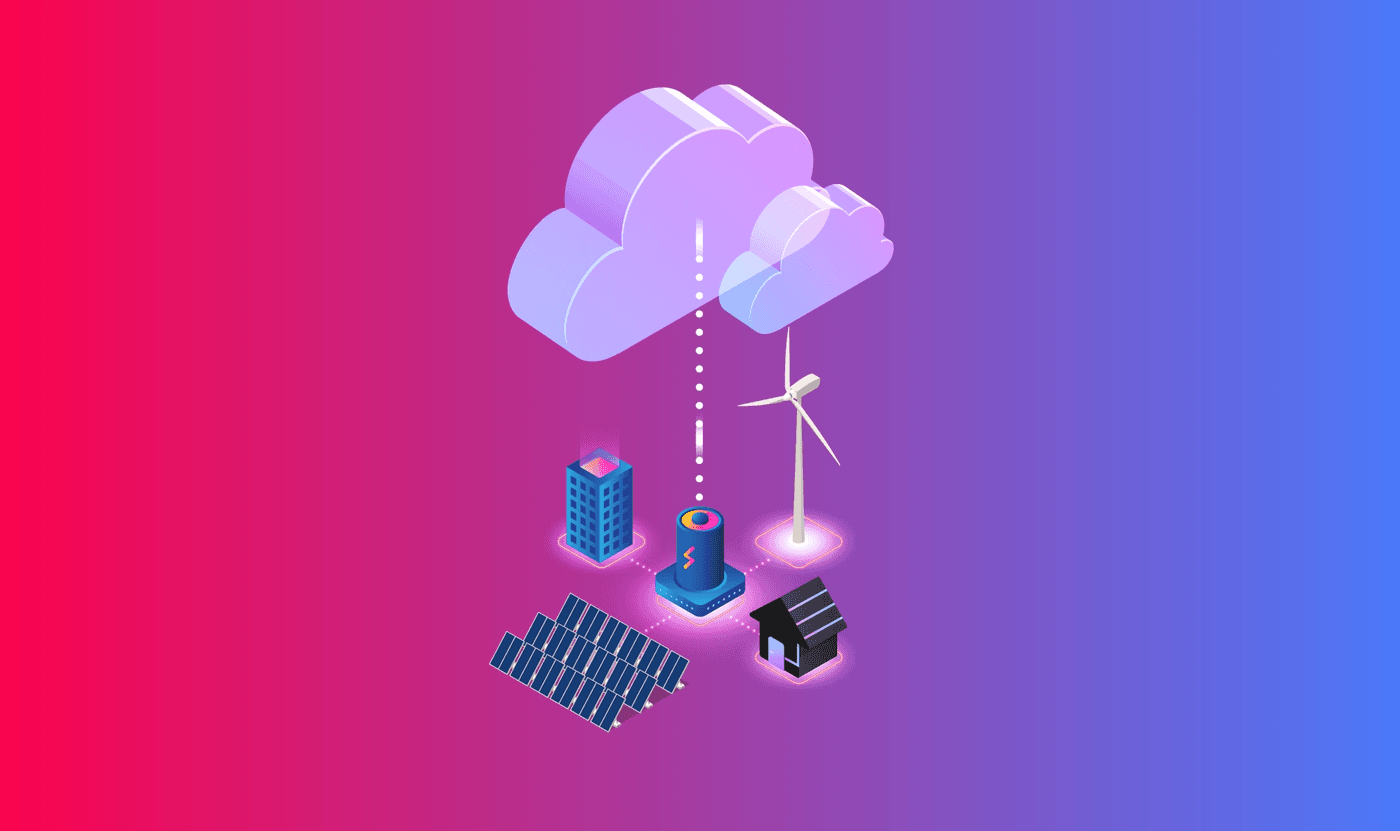How the Cloud Is Transforming the Energy Sector: 7 Practical Use Cases
Energy is undergoing a phenomenal transformation.
The energy industry is one of the key innovation vectors in the fourth industrial revolution, dubbed Industry 4.0, already redefining the way the world works.
Energy trends are shifting to renewables, advanced digitisation, and customer engagement—and even customer involvement in energy generation.
Yet, 82% of power and utility companies globally are not ready for market transformation.
It’s no longer enough to think of energy as a simple commodity. To distinguish themselves from emerging competition and to solidify themselves as industry leaders, energy providers must embrace new means of digital differentiation.
And at the heart of this digital differentiation is cloud.
In this article, we’ll address the biggest challenges facing the energy industry today and demonstrate how the cloud can be (and is being) used to overcome them.
6 Pressures on the Energy Sector
Before we can look at the important role of the cloud in the transformation of energy, let’s consider the key challenges facing the industry right now.
1. The global pandemic
With everything going on in the world, there is increasing pressure to put customers first, to respond to fluctuating demand, and above all to be flexible to new situations. Services need to be completely digitised and friction-free so customers don’t seek out other providers who have adapted faster.
2. The rise of open data
People are increasingly suspicious of companies that not only consume but analyse a lot of customer data. The industry is faced with new data legislation like the Consumer Data Right (CDR) in Australia and the EU’s General Data Protection Regulation (EU). Open Energy in Australia, for example, requires energy companies to open up energy plans, pricing, and provide customer’s own data back to that.
Open data is arguably one of the greatest distributors of opportunity in modern times. By extending the potential of using data from data holders to others in the data lifecycle, the collective can leverage data to increase productivity. Differentiators in the market will recommend optimised plans and you need to keep up.
3. The green agenda
Renewables are increasingly popular among all consumer market sectors with a disposable income, and are increasingly mandated via new legislations worldwide.
Energy companies need to be investing significantly in green solutions—not just in harvesting via renewables, but going green throughout business infrastructure and supply chain. We’ve shared 8 ways the cloud can be leveraged to reduce your ecological impact.
4. Rewards for loyalty/referrals
Loyalty programs can be an excellent source of customer behaviour data. With one third of Australians active participants in Westfarmers owned FlyBuys–a massive, multi-company loyalty program–high traffic umbrellaed companies are able to conduct extremely specific marketing strategies, as well as tailored loyalty options according to gathered loyalty data.
5. Large funding for rapid customer acquisition/buy in
Watch energy transformation action in real-time with innovative tech-based energy startups, with large seed rounds, acquisitions, and frenzied IPOs. With higher levels of investments, companies can afford to get customers on board early, cutting out the competition and retaining them through innovative customer experience strategies.
6. Threat of digital startups
Digital startups are able to enter the energy market more easily than ever before. With reduced entry costs and low barriers for customers to change providers, digital startups can take greater risks than established energy providers.
They can target smaller customer segments, offering refined customer experiences suited to their niche market. The rise of digital startups places additional pressure on companies to innovate, remain competitive and prioritise customer experience.
How the Cloud Is the Answer
How can energy companies manage to keep up? Stay compliant, retain customers, battle the startups, and innovate?
Cloud is the most critical enabling technology to allow you to achieve all this, and more.
In our recent State of the Public Cloud in the Enterprise report, we uncovered the following:
- 99% of enterprises found significant technical benefits in adopting public cloud
- 77% of enterprises are using the public cloud in some capacity
- 81% of enterprises believed they were able to innovate more quickly with the public cloud than on-premises solutions
- And, while 48% cited security and 37% compliance as the main barrier to (further) cloud adoption, 64% found cloud more secure than on-premise implementations
But how exactly does it enable innovation opportunities?
The Cloud Unlocks Data Innovation
Digital transformation within any industry is driven by massive data gathering and mining activities, and energy companies must be undertaking these activities across all business vectors: digital usage, customer interactions and behaviours, competition analysis, technology trends and predictions, energy usage trends, and more.
In the energy industry, we are already seeing companies realise value through using data to monitor their infrastructure, optimise operation of complex energy systems (e.g. batteries, wells, stations), forecast supply and demand, adapt to changes in energy market trading conditions and A/B test uplifts to customer experience.
With massive hardware infrastructure, processing power, and cutting edge technologies needed to facilitate these activities, it simply makes sense to employ a cloud solution instead of investing in ownership and management of these expensive undertakings. By using a cloud first strategy you can be assured that your systems are resilient.
The proof is in what businesses are doing right now.
How to Build a Cloud Landing Zone That Delivers Real Business Value
Many cloud adoption initiatives fail. It does not have to be this way!
The key to a strong cloud initiative is a rock solid foundation: a secure, reliable and high-performing Cloud Landing Zone!
7 Cloud Use Cases in the Energy Sector
The cloud is transforming the energy sector from the way suppliers source their energy to how they interact with customers.
We’ve pulled together a list of use cases of the cloud in the energy sector below.
1. Improve customer experience
There are many ways that the cloud can be used to boost customer engagement and improve overall customer experience, such as offering customers real-time insights into their current and forecasted energy usage, suggesting savings opportunities based on their patterns of energy usage or improving the call centre experience.
Let’s look closer at how cloud-hosted contact centres can improve customer experience.
Traditional call centres have their limitations—especially when it comes to remote working. Companies should consider deploying cloud-hosted contact centres like Amazon Connect, to improve customer communication and boost customer engagement.
For instance, Contino recently demonstrated the value of Amazon Connect at a leading utility company.
- Allow agents to work from home with simply internet, a browser, and a headset
- Use Amazon Lex and Amazon Polly, chatbots, to enhance agent productivity levels
- Integrate with advanced cloud products using Amazon Connect with connections to AWS databases like DynamoDB, which can then leverage machine learning services such as speech recognition and sentiment analysis for improving processes and scripts. Feeding all this back into your CRM like Salesforce can help really personalise services for each individual customer.
2. Use cloud technology for predictive maintenance
Traditional energy companies require highly specific machinery and asset maintenance systems.
By employing cloud asset management systems and machine learning algorithms to identify trends and determine the best times for maintenance scheduling to avoid downtimes, and management of inventory/backups, you can automate these processes so your unexpected outages are all but eliminated.
The cloud allows for real time monitoring of assets, ensuring operational efficiency and transparency.
For instance, AWS’s predictive equipment health stack includes data collection across IoT and other devices, AWS IoT Analytics, Maintenance & Workforce Management System combined with Amazon Mobile for automation for work crews, and SageMaker with Big Data Analytics to learn new patterns including failures from the data for increasingly accurate predictions.
3. Predict customer churn and customer friction
Customer churn is an indication you’re either doing something wrong or someone is doing your business that much better than you.
And it’s expensive, too. In our report The Value of Predicting Customer Churn we found that studies show a 5% increase in customer retention rates results in 25% – 95% increase in profits.
To reduce churn and customer friction you need to predict these events and catch customers before they take their business elsewhere. Use machine learning to predict friction – for example, if someone doesn’t submit a metre reading, they are likely to get bill shock and this causes friction to the customer. To avoid this, you could use automated notifications to avoid this sense of shock.
During COVID, where there is actually an increase in customer usage of energy due to working from home, the challenge is then about predicting customers making defaults on their payments because of bill shock.
This can be done, for example, with a combination of Amazon Aurora machine learning, SageMaker, and Amazon Comprehend for sentiment analysis in customer service.
4. Enable new ways of working to become more efficient and resilient
The past year has seen an accelerated move away from the office to more non-traditional places of work. And the way we’re working is evolving too.
This is especially apparent in the energy industry where the workforce is highly distributed across sites and large portions of the workforce spend some or all of their time onsite, away from an office.
Using the cloud to change the way utility providers operate, enables you to adopt an agile approach which supports innovation and operational efficiency.
Agility also means that you can become more responsive to unexpected challenges, increasing market resiliency. As a highly regulated industry, energy companies need to be ready to adapt to changing circumstances.
Leveraging the power of cloud to change your operating model will help bring about favourable change. If it’s work from home, services such as Amazon Workspaces can be used anywhere as desktop-as-a-service. Identity management solutions allow employees to go anywhere with security inbuilt.
5. Real-time data and analytics
Part of agility in general is the ability to quickly make difficult business decisions: know when to change direction, try something new, stop a project, and the like.
To be able to make these sorts of decisions fast, you can’t wait for your data analysts to produce an in-depth report for the end of the quarter. Real-time data and analytics solutions are needed to be able to quickly identify both issues and successes.
By tracking customer energy usage, customer interactions with your app/websites/contact centre and new customer acquisitions in real-time, you can gain live insights into the impact of new campaigns (e.g. marketing efforts, new product offerings, etc.). This enables smarter, faster, data-driven decisions as to whether to scale out these campaigns or not.
Having these real-time insights can also be critical in guiding responses to external events that impact customer energy usage. Imagine having immediate insights into the shift in energy demand due to Covid and real-time predictions around which customers were likely to seek out cheaper plans (or cheaper energy providers) due to their increased costs.
Or imagine how much better you could control customer experience during outages if you had cloud-connected IoT technology monitoring your key infrastructure. Not only could you respond to outages faster (and even preempt them), but you could trigger notifications based on the outage to inform the customer you are working to repair it before they are even aware of it.
These agile outcomes are only possible with powerful data and analytics services like those offered by CSPs. Having scalable compute, affordable storage and managed solutions enables teams to rapidly innovate, gain faster insights into their business and improve customer experience.
6. Improve collaboration
As fantastic as infrastructure, automation, and software solutions are, you still need people to power these solutions. And as always, collaboration is the way to find the optimal solution - two heads are better than one. Removing barriers to and friction in collaborative efforts is also enabled by the cloud.
For example, cloud-based Microsoft 365 business implementations allow team members to work from anywhere, concurrently on Microsoft apps, with smart knowledge libraries, Teams with inbuilt tagging and inline file editing, plus advanced user management.
From our M365 Migration at JERAGM the company observed that “Simple tasks like setting up a meeting, collaborating with a team and sharing a document have gone from being difficult and time consuming to a fast, seamless process.”
7. Reduce Ecological Cost
Due to ambitious net zero targets set by governments, we expect to see an alignment of the cost of business with the ecological cost. The energy sector in particular is under more pressure than ever to address its environmental impact through smarter and greener technology solutions.
The cloud can be used to reduce ecological costs in the energy sector by following the three Rs of cloud: Reduce, Reuse and Recycle.
Cloud computing has the potential to reduce time to market. By cutting down the time it takes to provision infrastructure, the cloud can significantly reduce your time to market, freeing up more time for innovation and enabling more growth opportunities.
You can reuse infrastructure and code. The benefits of using cloud platforms for your infrastructure is that the CSPs themselves look after the underlying physical layer, allowing us to reuse the virtual infrastructure we can provision (and to reduce when not needed). Using code to describe and instantiate your infrastructure allows for that code to be reused and repurposed repeatedly, removing costly reiterations, and drastically reducing rework.
And lastly, you can recycle best practices and business processes. Cloud is a known quantity in the technological landscape, and the Recycling of best practices, common templated architectures, governance and controls are all possible. The CSPs themselves are continually innovating to make the known best practice more easily achievable, meaning less time, effort, and ecological cost incurred in enterprise success.
Case Study: Partnering With Origin Energy for Its Cloud Migration Journey
With over 4 million customers Australia-wide, Origin Energy is one of the big three energy retailers in the Australian market.
As part of Origin’s Cloud 2022 roadmap, we partnered with this provider to “enable more agility, elasticity, resilience and efficiency, as well as to optimise operating costs.”
With cross-functional teams with a blend of Origin and Contino members, we worked to establish Agile processes, plan and deliver cloud treatments, DevOps practices and toolchains, and evolutionary pipelines to not only migrate from physical data centres to the cloud. With the process, we ensured that not only was the migration successful, but practices and teams put in place for maintenance, building, and remaining leaders in the space.
Read more in our case study: Origin Energy Partners With Contino for Its Cloud Migration Journey.
Cloud is a key part of any data-driven strategy
If you’re not thinking cloud-first, then it’s time to prioritise. Your technology budget should be strategically investing in data-driven solutions to avoid incidents and reduce risk, improve customer satisfaction, and remain competitive in an industry that’s going through a highly significant and rapid change.







